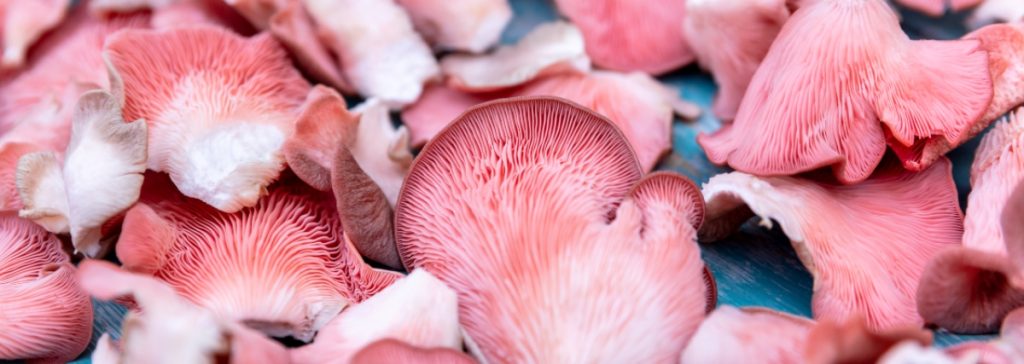Most people will go their entire lives without ever seeing a pink mushroom.
So if you’ve found a pink oyster mushroom or are planning on growing them, you should consider yourself lucky!
In this article, you’ll learn all about pink oyster mushrooms. A warm weather oyster variety that’s the fastest-growing type of oyster mushroom available.
You’ll learn what they look and taste like and how to clean and store them. Plus you’ll learn how to grow them yourself and discover some recipes to try out.
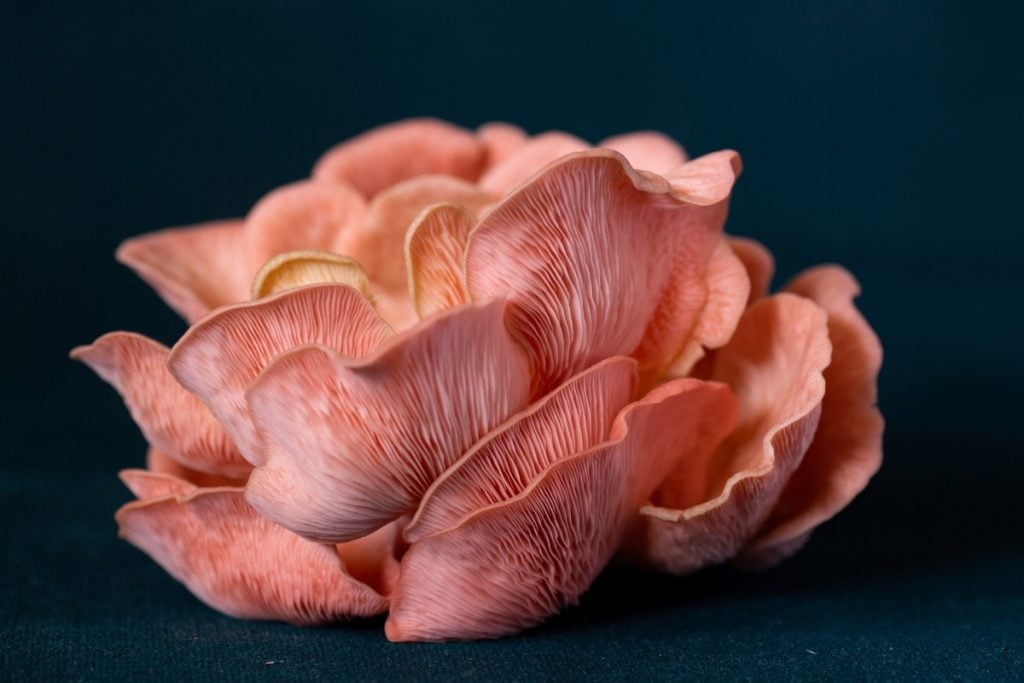
What Do Pink Oyster Mushrooms Look Like?
The pink oyster mushroom has the same shape and structure as other oyster mushrooms. They’ve got that distinctive shelf-like or fan-shaped oyster cap.
Pink oysters are small to medium in size. Their caps typically range from 2 to 5 centimeters (0.79 to 1.97 inches) in diameter.
These mushrooms will often grow in big clusters.
What really sets the pink oyster mushroom apart is its vibrant pink color.
Both the top of the cap and underside of the mushroom (including gills) are all pink.
Their striking appearance makes them popular at farmer’s markets and when selling directly to chefs.
Pink oysters are at their most colorful when they’re young. As they start to age, their color becomes more faded to a creamy pink color.
If you’re growing pink oyster mushrooms, don’t be surprised that their mycelium starts out white. This will change and start to become pink as the mycelium matures.
Whether you’re selling to restaurants or direct to consumers, it’s best to inform buyers upfront that the pink colors of these mushrooms will largely disappear once cooked.
They will turn to more of a cream or brown color after they’re cooked. We recommend letting buyers know this up front so there isn’t any confusion or disappointment.
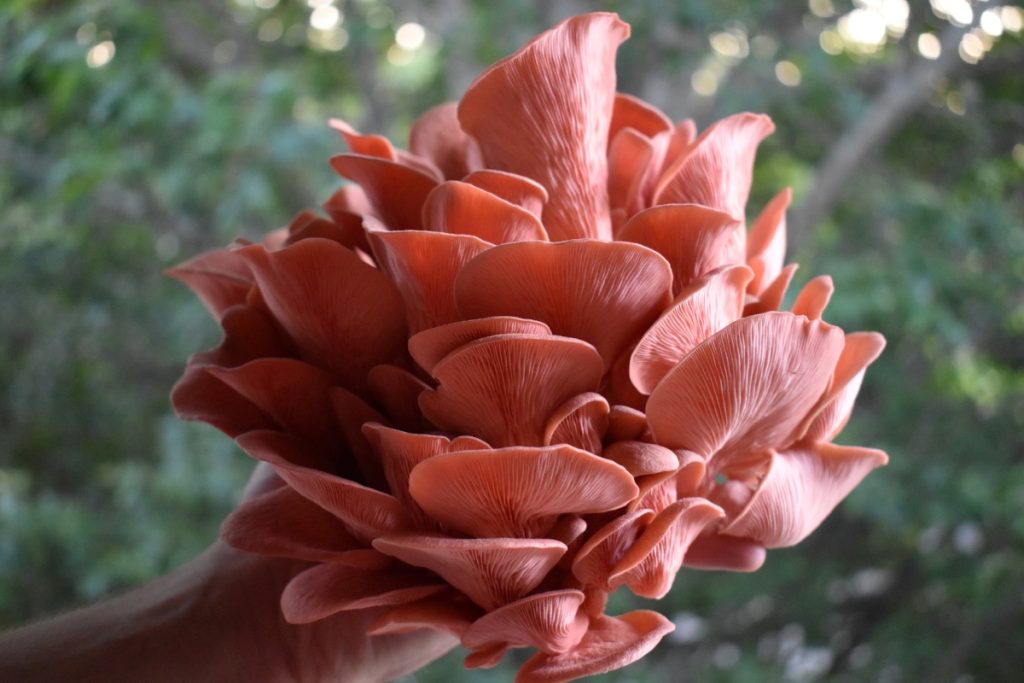
What Do Pink Oyster Mushrooms Taste Like?
Pink oyster mushrooms taste bitter when eaten raw. They need to be cooked thoroughly to get rid of the bitter taste.
When cooked, they have a mild flavor similar to most other oyster mushrooms. Although compared to button mushrooms, they’ve got a much deeper and more rich flavor.
Some people say that the pink oyster mushroom taste has a slight seafood flavor.
If you cook them up until they’re brown and a bit crunchy, pink oysters even make a great vegetarian substitute for bacon.
Depending on their growing conditions, pink oysters can range in texture from delicate and thin to meaty and thick.
Generally they do tend to be a bit more chewy than other types of oyster mushrooms though. Sometimes even a bit woody and tough.
That’s not necessarily a negative in all recipes though. They’re ideal for soups or stir frys where you want your mushrooms to retain more of their structure, instead of just turning to mush.
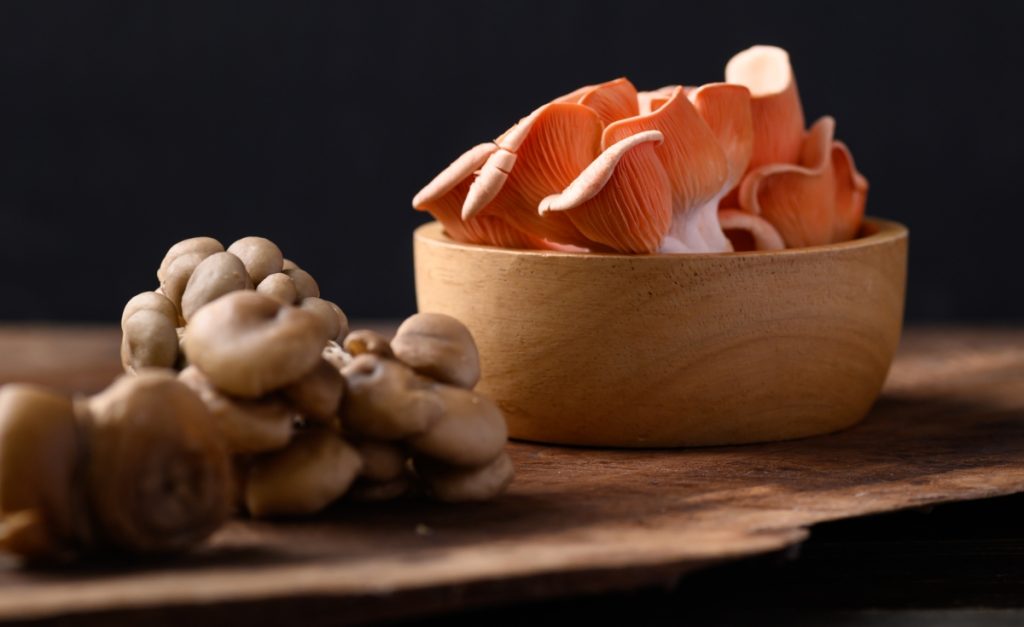
Where and When Do Pink Oyster Mushrooms Grow?
Pink oysters are a warm temperature mushroom. They prefer to grow in tropical climates and high humidity.
They’re most commonly found on tropical hardwood trees in Mexico, Indonesia or other locations with similar climates.
The bad news is that pink oysters don’t grow wild in the colder climates of North America and most of Europe.
So unless you live in the tropics or somewhere exceptionally warm, it’s very unlikely that you’ll ever encounter pink oysters in the wild.
In the tropics, pink oysters can be found growing during the warmer months from April to September.
The good news about pink oysters being so heat tolerant means that they can be easily grown in the middle of summer.
Many cultivators will switch between growing blue oysters in the colder months and pink oysters during the heat of summer.
One big bonus of growing pink oysters is that they don’t require tons of fresh air like blue oysters. Ventilation and getting enough airflow can be a tricky part of growing oysters.
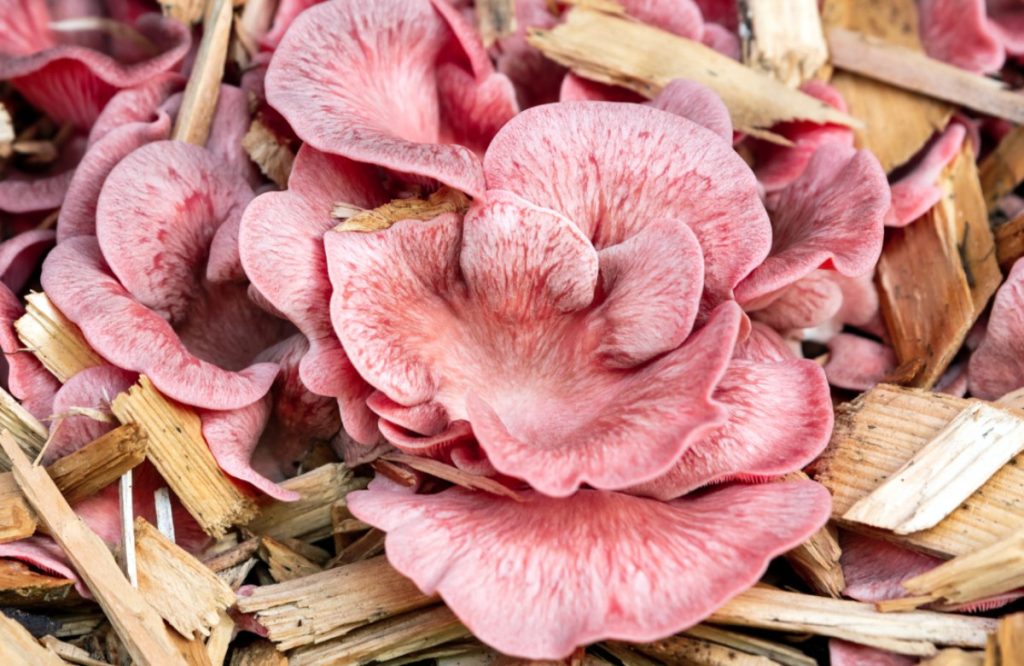
How To Grow Pink Oyster Mushrooms Yourself
For the most part, pink oyster mushrooms are grown in the same way as all other oyster mushrooms.
You can follow along with How To Grow Oyster Mushrooms: The Ultimate Step By Step Guide for most of the information you’ll need.
Rather than go over the same general information, we’ll just discuss some of the key differences to keep in mind when growing pink oysters.
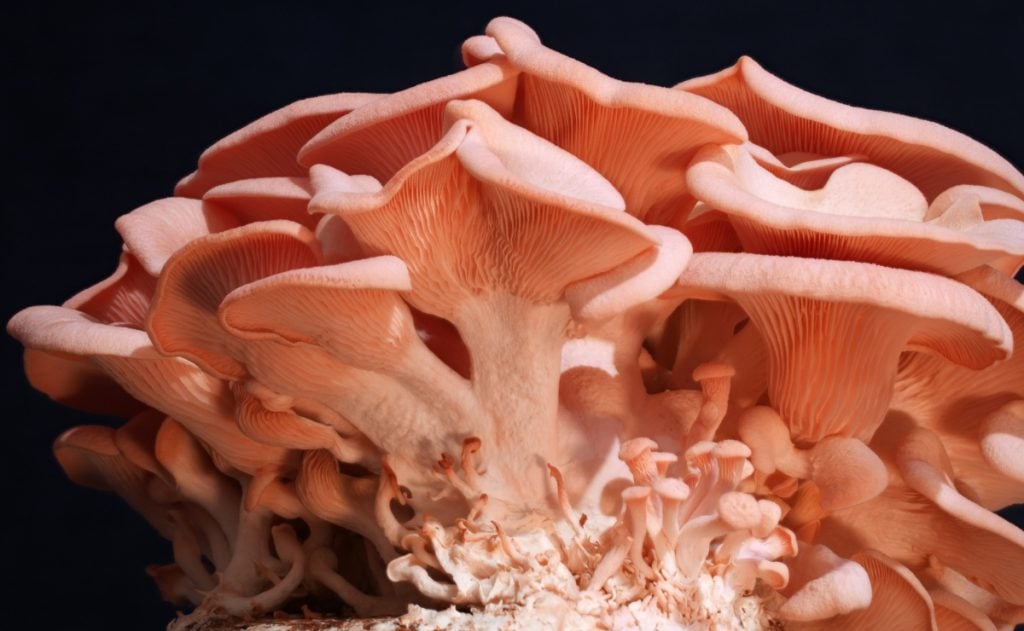
Pink Oyster Mushroom Substrate
You can grow pink oyster mushrooms on any of the substrates that you’d use for other types of oysters.
That includes materials like paper, cardboard, coffee grounds, mulch, soy hulls, straw or hardwood.
However, in our experience we’ve found that straw works the best and allows for the fastest colonization.
Hardwood pellets or supplemented hardwood sawdust blocks can be used. However, your pink oyster mushrooms will tend to be thicker and tougher when grown on a wood-based substrate.
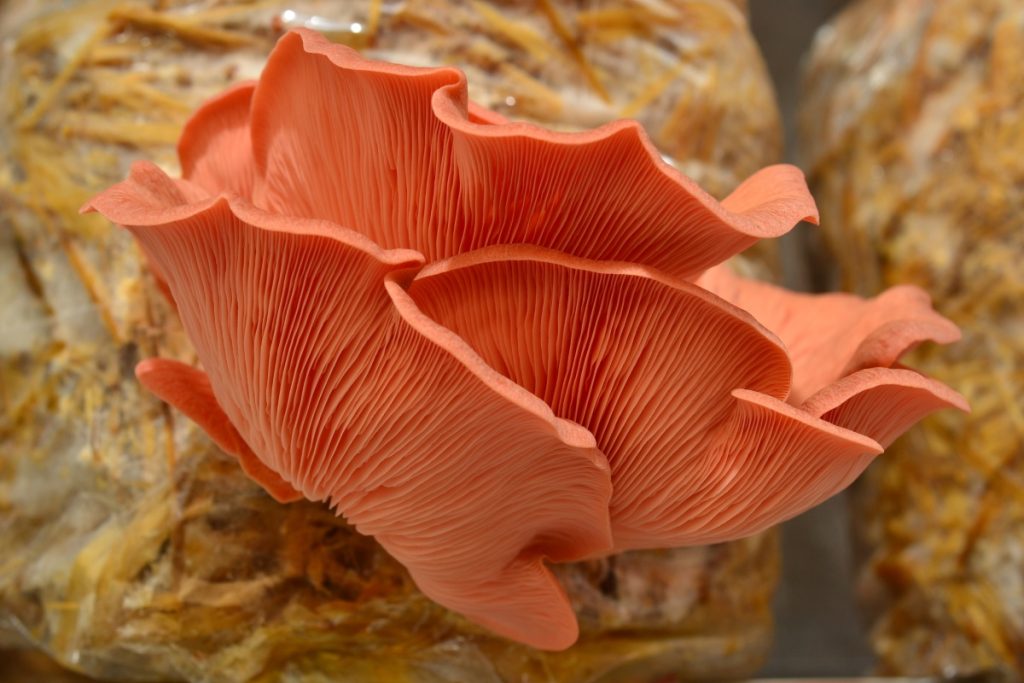
Pink Oyster Mushroom Colonization
Pink oyster mushrooms have a thinner, more wispy mycelium than other varieties of oyster mushrooms.
The mycelium will start off white. So don’t be concerned that you received the wrong strain when you start to see it.
The mycelium will turn to a pinkish color toward the end of the colonization phase.
As with other oyster mushrooms, poly tubing works great to hold all of your straw and spawn.
Alternatively you can use large plastic buckets with holes drilled in the side. These can be re-used and will cut down on your plastic waste.

Fruiting Pink Oyster Mushrooms
Pink oysters prefer fruiting conditions with humidity levels of at least 70% (at GroCycle, we prefer around 85%) and a temperature range of 20 to 30 C (68 to 86 F).
Pink oysters are the fastest growing oyster mushroom.
Your pink oyster mycelium will often start pinning even before it looks like it has fully colonized the substrate. This can start to happen as early as day 9.
From a bag of 5 lbs (2.27 kg) of straw and spawn, you should expect to get at least 1 lb (0.45 kg) of fresh mushrooms.

Harvesting Pink Oyster Mushrooms
When to harvest your pink oysters is just when the caps begin to curl up.
It’s very important to harvest your pink oyster mushrooms before they start to drop their spores.
Pink oyster mushrooms produce the largest amount of spores of any oyster mushrooms that we’ve grown.
If you wait too late to harvest, your entire grow room will be covered in pink spores. It’s a lot of unnecessary cleanup and you also don’t want to be breathing in the spores either.
If you want to get future flushes out of your bags, cut off entire clusters of pink oysters with a sharp knife.
Avoid simply twisting the clusters off, as you can damage the mycelium and create an opening for contamination to occur.
To get a second flush of pink oysters, simply keep your bags well hydrated and leave them in your fruiting room. Watch for signs of contamination.
Pink oysters are one of the easier varieties of oyster mushrooms to get a second or third flush from.
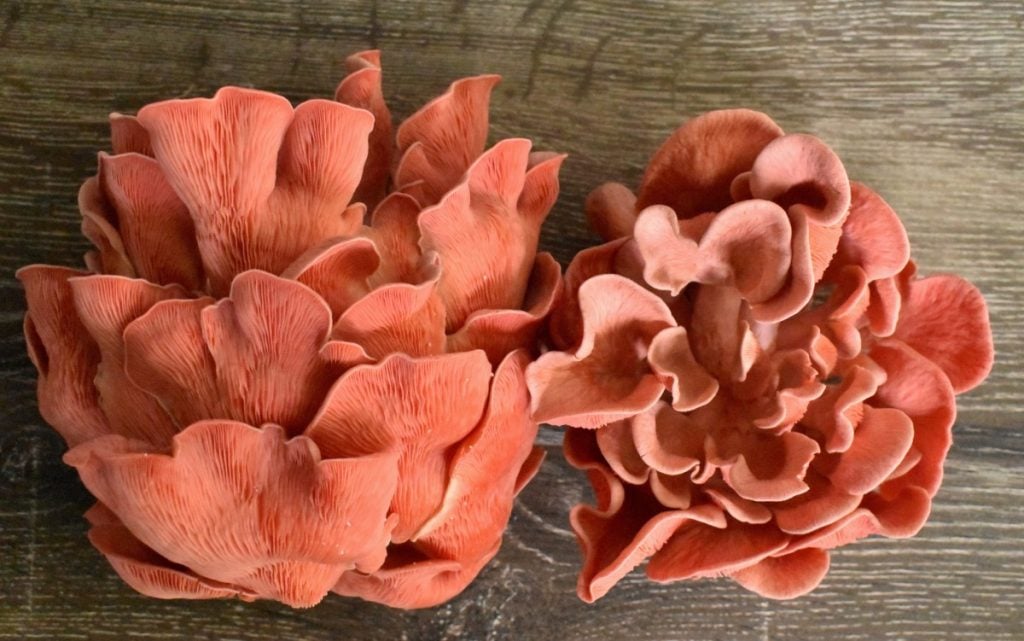
How Long It Takes To Grow Pink Oyster Mushrooms
Pink oyster mushrooms grow really fast and can be producing fruits in as little as 3 weeks.
Pink oyster spawn will colonize your grow bags and start to pin in just 9 to 14 days.
Once you place your bags in fruiting conditions, you could have your first flush of pink oysters in under a week. On the longer end, your fruiting phase might take up to 12 days.
After your first harvest, you should get a second flush of pink oysters after another 7 days or so.

How To Clean and Store Pink Oyster Mushrooms
One major downside of pink oyster mushrooms is that they’ve got a shorter shelf life than most other mushrooms.
Even in ideal conditions, pink oysters will sometimes only last a couple of days in the fridge before going bad.
Proper storage and cleaning is key to making the most of your mushrooms.
Never wash your pink oysters before storing them, as this will cause them to start going bad even faster.

Storing Pink Oyster Mushrooms
It’s best to eat your pink oysters as soon as possible after harvesting. But if that’s not possible right away, here are some ways that you can store them.
Refrigerate Them
Refrigerated pink oysters will last for a couple of days before they start to go bad.
To make them last as long as possible, store your unwashed pink oysters in a paper bag. The paper will absorb some excess moisture and help prevent your mushrooms from getting soggy.
Store them in the main compartment of your fridge, not in a produce drawer.
Take care not to place your pink oysters near any strong-smelling foods like onion, garlic or ginger. They will absorb the scents of foods around them and it’ll affect their taste.
Freeze Them
Pink oysters will last in the freezer for up to a month.
Separate any clusters of pink oysters into individual caps and then seal them in a plastic freezer bag. You can freeze them either raw or cooked.
When you’re ready to use them, all you need to do is thaw them out for about 30 minutes.
One downside is that freezing may negatively impact the texture of your pink oyster mushrooms.
Dehydrate Them
Properly dehydrated pink oysters will last for up to 6 months.
If you have a food dehydrator, that will produce the best results. But you can also put them in the oven on the lowest temperature to dry them out.
You can even air dry them in direct sunlight. Drying pink oysters in sunlight has the added benefit of increasing their Vitamin D content.
Don’t be surprised if your pink oysters look very small after drying them out. They’ll regain most of their original size when you rehydrate them.
When you’re ready to cook with them, just soak in water for a couple of minutes and then use them like fresh mushrooms.
Can Them
Canned or pickled pink oyster mushrooms will last for up to a year.
To can pink oysters, follow the instructions here. You will need basic canning supplies like jars and a pressure cooker.
Here is a recipe if you’d like to try pickling pink oyster mushrooms.
How To Clean Pink Oyster Mushrooms
Pink oysters don’t get very dirty, especially if they’ve been grown commercially. So they require only a minimal amount of cleaning.
To remove any small bits of dirt or substrate, it’s best to simply wipe them off with a slightly damp paper towel or cloth.
You can use a mushroom brush if you’ve got one. They’re specialized brushes for cleaning mushrooms, which you can buy on Amazon for around $10 (£7.65).
Pink oysters are particularly fragile and even a mushroom brush may cause a lot of damage. So be extra careful when cleaning them.
Water should be used only as a last resort when cleaning pink oysters. Since they’re porous, they act like sponges and soak up water.
Once they’ve absorbed extra water, it becomes hard to get them crispy when cooking.
If you need to use water, place them in a colander and only give them a quick rinse under running water.
As you’re cleaning, check your pink oysters on all sides. Cut off any parts where you see mold or discoloration.

Health Benefits of Pink Oyster Mushrooms
Along with being full of flavor, pink oysters also contain a lot of nutrition while being low in calories.
Pink oysters are high in protein and fiber, while low in sugar and carbs.
They’ve also been specifically studied for their antibiotic and antibacterial properties.
You also get all of the benefits from eating pink oyster mushrooms that you’d get from other varieties of oyster mushrooms:
- Cholesterol lowering
- Contain antioxidants
- High in iron, zinc, potassium and selenium
- High in vitamins B1, B3, B5 and B12 (great meat alternative)
See our article on the Health Benefits of Oyster Mushrooms for more information.
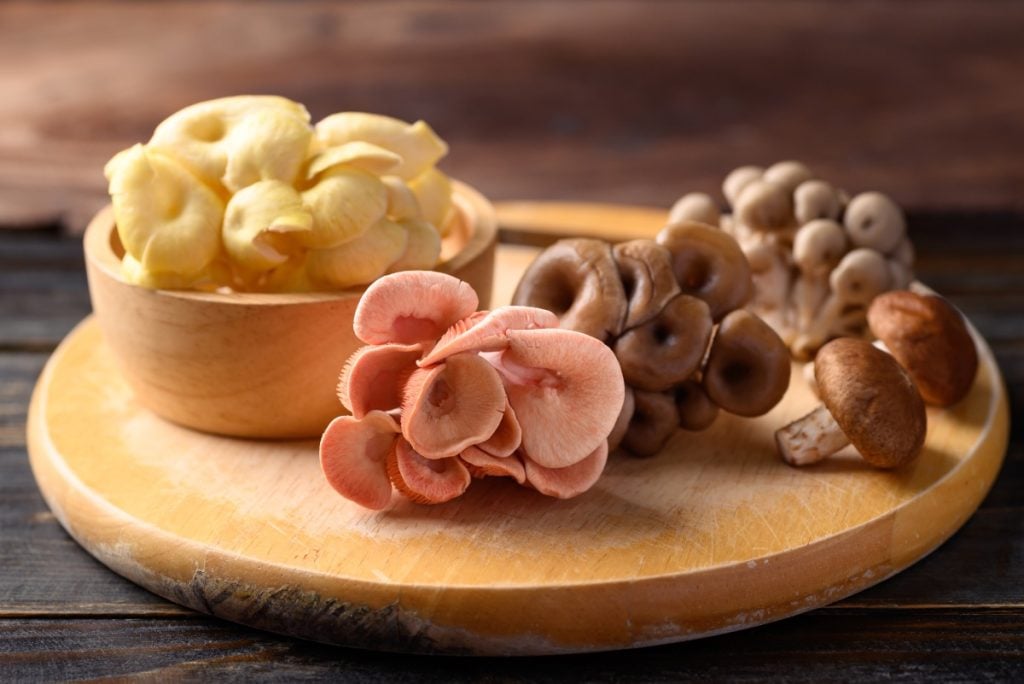
Other Mushrooms That Pink Oyster Mushrooms Are Commonly Confused With
There aren’t many pink mushrooms found in nature.
Combine that with the fact that oyster mushrooms in general are quite easy to identify. So it shouldn’t be too hard to tell a pink oyster from other mushrooms.
As we discussed above, pink oysters only grow in the wild in tropical regions.
So if you’re in a temperate area of North America or Europe, your chances of finding pink oysters are highly unlikely.
One pink colored mushroom that might be found in the same areas as pink oysters is the pink domecap (Rugosomyces carneus).
However, the pink domecap has more of a toadstool shape and grows in grass instead of on hardwood.
Ghost fungus (Omphalotus nidiformis) is found in Australia, New Zealand, Japan and India. So it may be found in the same areas that pink oysters will grow.
While ghost fungus has funnel-shaped caps that might be confused with oysters, they are white or cream-colored instead of pink.
How To Cook Pink Oyster Mushroom (Pink Oyster Mushroom Recipes)

You can use pink oyster mushrooms in any recipe calling for oyster mushrooms. However, here are a few of our favorites:
Pink Oyster Mushroom “Bacon”
This pink oyster mushroom recipe might surprise you at how close it actually tastes like bacon. Plus it’s super easy to make.
Ingredients:
- Pink oyster mushrooms
- Olive oil, butter, or other frying substitute
- Salt
Directions:
Step 1: Add a good amount of olive oil or butter to a hot frying pan. To really up the bacon flavor, non-vegetarians can fry in leftover bacon fat or pork lard.
Step 2: Fry your pink oysters over a medium heat, turning occasionally.
Step 3: Let them fry until they start to get crispy and brown. They’ll look and feel like mushroom chips.
Step 4: Once they’re crispy, add salt or any optional spices that you prefer.
Tips:
- You can serve your pink oyster “bacon” hot or cold.
- To make smaller pink oyster “bacon bits” that you can put on salads, tear the mushrooms into small pieces before cooking.
Penne With Pink Oyster Mushrooms

(Inspired by the recipe Rigatoni with Pink Oyster Mushrooms and Peas by Annie of bewildeats.com)
Ingredients:
- 200 grams (7 oz) penne pasta
- 250 grams (8.8 oz) pink oyster mushrooms
- ½ cup chopped onion
- 2 cloves garlic
- 2 cups whole milk
- 2 tbsp flour
- ½ cup parmesan cheese
- ¼ cup white wine
- 6 tbsp olive oil
- Lemon zest
Directions:
Step 1: Cook your pasta following instructions on the package
Step 2: Heat olive oil in a skillet. Add mushrooms and saute for approximately 5 minutes or until brown. Then remove them from the pan and set aside.
Step 3: Add onion, garlic and flour to the pan. Stir for 5 to 10 minutes until soft.
Step 4: Mix in white wine and milk. Simmer for 5 minutes.
Step 5: Mix in parmesan cheese, pasta and mushrooms to the sauce and cook for an additional 2 minutes.
Step 6: Garnish with lemon zest and serve.
For even more recipes, be sure to read 5 Easy and Delicious Oyster Mushroom Recipes.
Final Thoughts
Pink oyster mushrooms are great for growing at home in the summer. Or almost any time of year if you live in a tropical climate.
They’ll fruit faster than any other type of oyster mushroom and produce multiple flushes.
The pink oyster mushroom has a shorter shelf life than other oysters. So the best way to enjoy them is to harvest it yourself and use them within a day or two.
Their vibrant pink color makes them easier than other varieties to sell to chefs or customers. Just let them know that they won’t retain their stunning color once cooked!
